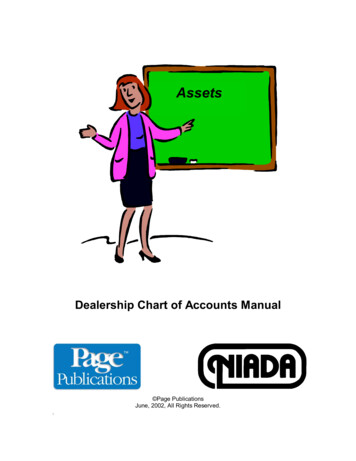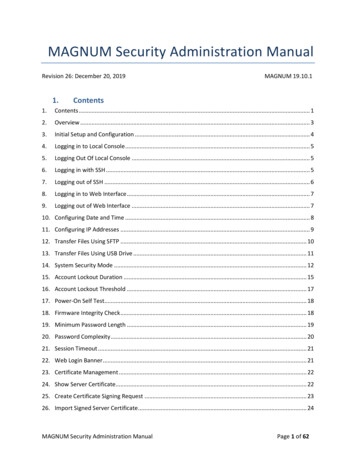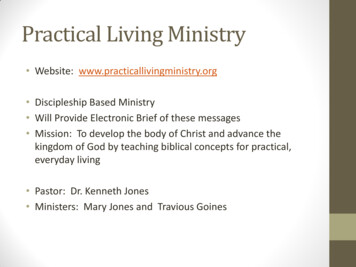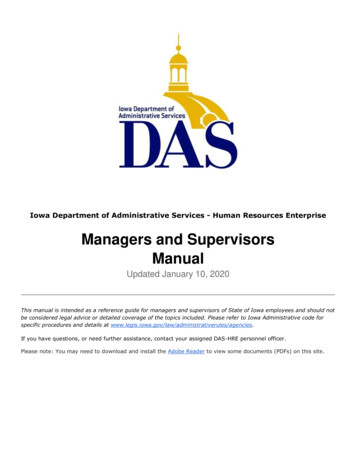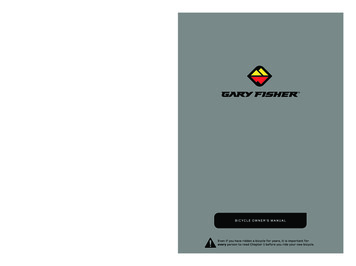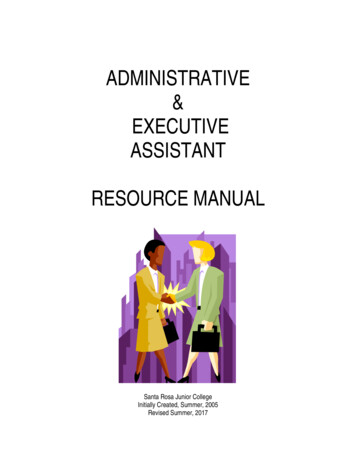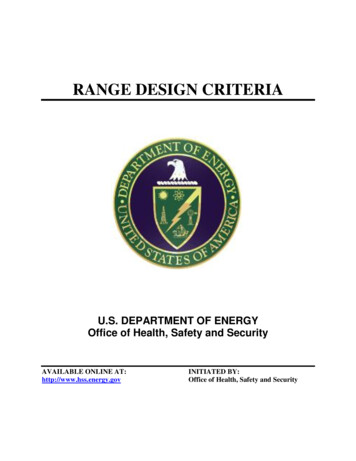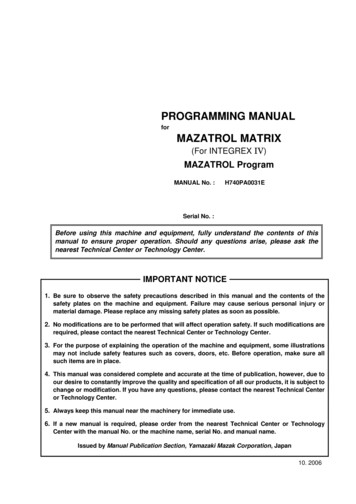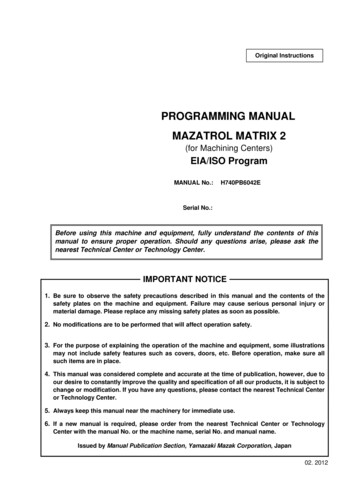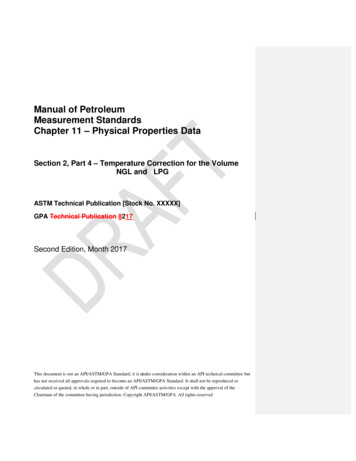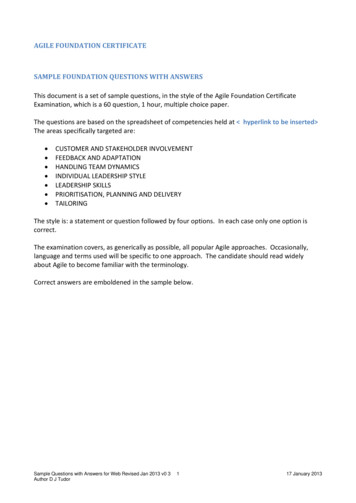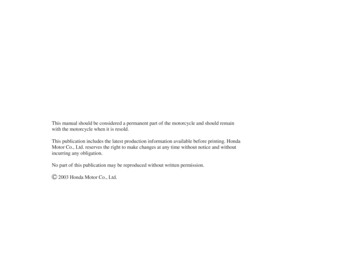
Transcription
03/03/07 12:59:42 31MEM600 001This manual should be considered a permanent part of the motorcycle and should remainwith the motorcycle when it is resold.This publication includes the latest production information available before printing. HondaMotor Co., Ltd. reserves the right to make changes at any time without notice and withoutincurring any obligation.No part of this publication may be reproduced without written permission.2003 Honda Motor Co., Ltd.
03/03/07 12:59:44 31MEM600 0022004Honda VTX1300CVTXOWNER’S MANUAL
03/03/07 12:59:50 31MEM600 003IntroductionCongratulations on choosing your Hondamotorcycle.When you own a Honda, you’re part of aworldwide family of satisfied customers people who appreciate Honda’sreputation for building quality into everyproduct.Before riding, take time to get acquaintedwith your motorcycle and how it works.To protect your investment, we urge youto take responsibility for keeping yourmotorcycle well maintained. Scheduledservice is a must, of course. But it’s just asimportant to observe the break-inguidelines, and perform all pre-ride andother periodic checks detailed in thismanual.IntroductionWe also recommend that you read thisowner’s manual before you ride. It’s fullof facts, instructions, safety information,and helpful tips. To make it easy to use,the manual contains a detailed list oftopics at the beginning of each section,and both an in-depth table of contents andan index at the back of the book.As you read this manual, you will findinformation that is preceded by asymbol. This information isintended to help you avoid damage to yourHonda, other property, or the environment.
03/03/07 12:59:57 31MEM600 004IntroductionRead the Warranties Booklet (page 197 )thoroughly so you understand thecoverages that protect your new Hondaand are aware of your rights andresponsibilities.If you have any questions, or if you everneed special service or repairs, rememberthat your Honda dealer knows yourmotorcycle best and is dedicated to yourcomplete satisfaction.You may also want to visit our website atwww.honda.com.Happy riding!California Proposition 65 WarningWARNING: This product contains oremits chemicals known to the State ofCalifornia to cause cancer and birthdefects or other reproductive harm.Please report any change of address orownership to your Honda dealer so wewill be able to contact you concerningimportant production information.Introduction
03/03/07 13:00:02 31MEM600 005A Few Words About SafetyYour safety, and the safety of others, is very important. And operating this motorcycle safelyis an important responsibility.To help you make informed decisions about safety, we have provided operating proceduresand other information on labels and in this manual. This information alerts you to potentialhazards that could hurt you or others.Of course, it is not practical or possible to warn you about all hazards associated withoperating or maintaining a motorcycle. You must use your own good judgment.You will find important safety information in a variety of forms, including:Safety Labels –– on the motorcycle.Safety Messages –– preceded by a safety alert symbolDANGER, WARNING, or CAUTION.These signal words mean:Safety Messagesand one of three signal words:
03/03/07 13:00:08 31MEM600 006A Few Words About SafetyYou WILL be KILLED or SERIOUSLY HURT if youdon’t follow instructions.You CAN be KILLED or SERIOUSLY HURT if you don’tfollow instructions.You CAN be HURT if you don’t follow instructions.Safety Headings –– such as Important Safety Reminders or Important Safety Precautions.Safety Section –– such as Motorcycle Safety.Instructions –– how to use this motorcycle correctly and safely.This entire manual is filled with important safety information –– please read it carefully.Safety Messages
03/03/07 13:00:17 31MEM600 007ContentsThese pages give an overview of thecontents of your owner’s manual. The firstpage of each section lists the topicscovered in that section.Motorcycle Safety . 1Important safety information youshould know, plus a look at the safetyrelated labels on your motorcycle.Instruments & Controls . 9The location and function of indicatorsand controls on your motorcycle andoperating instructions for variouscontrols and features.ContentsBefore Riding . 25The importance of wearing a helmetand other protective gear, how to makesure you and your motorcycle are readyto ride, and important information aboutloading.Basic Operation & Riding . 35How to start and stop the engine, shiftgears, and brake. Also, ridingprecautions and important informationabout riding with a passenger or cargo.
03/03/07 13:00:30 31MEM600 008ContentsServicing Your Honda . 51Why your motorcycle needs regularmaintenance, what you need to knowbefore servicing your Honda, an ownermaintenance schedule, and instructionsfor specific maintenance andadjustment items.Tips . 135How to store and transport yourmotorcycle and how to be anenvironmentally-responsible rider.Taking Care of the Unexpected . 143What to do if you have a flat tire, yourengine won’t start, etc.Technical Information . 171ID numbers, technical specifications,and other technical facts.Consumer Information . 193Information on warranties, emissioncontrols, how to get Honda servicemanuals, and.‘‘Reporting Safety Defects’’ . 202Table of Contents . 204Sequential listing of topics in thisowner’s manual.Index. 208Quick ReferenceHandy facts about fuel, engine oil, tiresizes, and air pressures.Contents
03/03/07 13:00:32 31MEM600 009
03/03/07 13:00:36 31MEM600 010Motorcycle SafetyThis section presents some of the mostimportant information andrecommendations to help you ride yourmotorcycle safely. Please take a fewmoments to read these pages. This sectionalso includes information about thelocation of safety labels on yourmotorcycle.Important Safety Information . 2Accessories & Modifications . 5Safety Labels . 7Motorcycle Safety1
03/03/07 13:00:41 31MEM600 011Important Safety InformationYour motorcycle can provide many yearsof service and pleasure if you takeresponsibility for your own safety andunderstand the challenges you can meetwhile riding.There is much that you can do to protectyourself when you ride. You’ll find manyhelpful recommendations throughout thismanual. The following are a few that weconsider most important.2Motorcycle SafetyAlways Wear a HelmetIt’s a proven fact: helmets significantlyreduce the number and severity of headinjuries. So always wear an approvedmotorcycle helmet and make sure yourpassenger does the same. We alsorecommend that you wear eye protection,sturdy boots, gloves, and other protectivegear (page 26 ).
03/03/07 13:00:48 31MEM600 012Important Safety InformationTake Time to Learn & PracticeEven if you have ridden other motorcycles,take time to become familiar with howthis motorcycle works and handles.Practice in a safe area until you build yourskills and get accustomed to themotorcycle’s size and weight.Because many accidents involveinexperienced or untrained riders, we urgeall riders to take a certified courseapproved by the Motorcycle SafetyFoundation (MSF). See page 28 .Ride DefensivelyThe most frequent motorcycle collisionhappens when a car turns left in front of amotorcycle. Another common situation isa car moving suddenly into your lane.Always pay attention to other vehiclesaround you, and do not assume that otherdrivers see you. Be prepared to stopquickly or make an evasive maneuver. Forother riding tips, see the booklet, You andYour Motorcycle: Riding Tips andPractice Guide, which came with yournew motorcycle (USA only).Make Yourself Easy to SeeSome drivers do not see motorcyclesbecause they are not looking for them. Tomake yourself more visible, wear brightreflective clothing, position yourself soother drivers can see you, signal beforeturning or changing lanes, and use yourhorn when it will help others notice you.Motorcycle Safety3
03/03/07 13:00:54 31MEM600 013Important Safety InformationRide within Your LimitsPushing limits is another major cause ofmotorcycle accidents. Never ride beyondyour personal abilities or faster thanconditions warrant. Remember thatalcohol, drugs, fatigue, and inattention cansignificantly reduce your ability to makegood judgments and ride safely.Don’t Drink and RideAlcohol and riding don’t mix. Even onedrink can reduce your ability to respond tochanging conditions, and your reactiontime gets worse with every additionaldrink. So don’t drink and ride, and don’tlet your friends drink and ride either.4Motorcycle SafetyKeep Your Honda in Safe ConditionIt’s important to keep your motorcycleproperly maintained and in safe ridingcondition. To help avoid problems, inspectyour motorcycle before every ride andperform all recommended maintenance.Never exceed load limits (page 33 ), anddo not modify your motorcycle (page 6 )or install accessories that would makeyour motorcycle unsafe (page 5 ).
03/03/07 13:01:00 31MEM600 014Accessories & ModificationsModifying your motorcycle or using nonHonda accessories can make yourmotorcycle unsafe. Before you considermaking any modifications or adding anaccessory, be sure to read the followinginformation.Improper accessories ormodifications can cause a crash inwhich you can be seriously hurt orkilled.Follow all instructions in thisowner’s manual regardingaccessories and modifications.AccessoriesWe strongly recommend that you use onlygenuine Honda accessories that have beenspecifically designed and tested for yourmotorcycle. Because Honda cannot test allother accessories, you must be personallyresponsible for proper selection,installation, and use of non-Hondaaccessories.Check with your Honda dealer forassistance and always follow theseguidelines:Make sure the accessory does notobscure any lights, reduce groundclearance and lean angle, limitsuspension travel or steering travel, alteryour riding position, or interfere withoperating any controls.Motorcycle Safety5
03/03/07 13:01:08 31MEM600 015Accessories & ModificationsDo not install any fairing or windshieldunless it was designed and tested byHonda for your motorcycle. Somefairings or windshields, even smallerones, can cause unstable handling ofyour motorcycle. This is especially trueif the fairing or windshield is poorlydesigned or improperly mounted.Do not add any electrical equipmentthat will exceed the motorcycle’selectrical system capacity (page 179 ).A blown fuse can cause a loss of lightsor engine power (page 163 ).Do not pull a trailer or sidecar with yourmotorcycle. This motorcycle was notdesigned for these attachments, andtheir use can seriously impair yourmotorcycle’s handling.6Motorcycle SafetyModificationsWe strongly advise you not to remove anyoriginal equipment or modify yourmotorcycle in any way that would changeits design or operation. Such changescould seriously impair your motorcycle’shandling, stability, and braking, making itunsafe to ride.Removing or modifying your lights,exhaust system, emission control system,or other equipment can also make yourmotorcycle illegal.
03/03/07 13:01:18 31MEM600 016Safety LabelsSafety labels on your motorcycle either warn you of potential hazards that could causeserious injury or they provide important safety information. Read these labels carefully anddon’t remove them.If a label comes off or becomes hard to read, contact your Honda dealer for a replacement.Motorcycle Safety7
03/03/07 13:01:29 31MEM600 017Safety Labels〈For USA〉〈For Canada〉8Motorcycle Safety
03/03/07 13:01:35 31MEM600 018Instruments & ControlsThis section shows the location of allgauges, indicators, and controls you wouldnormally use before or while riding yourmotorcycle.The items listed on this page are describedin this section. Instructions for othercomponents are presented in other sectionsof this manual where they will be mostuseful.Component Locations . 10Indicators . 13Controls & FeaturesFuel Valve. 17Choke Knob . 18Ignition Switch . 19Start Button . 20Engine Stop Switch . 20Headlight Dimmer Switch . 21Turn Signal Switch . 21Horn Button . 22Odometer/Tripmeter Select andReset Button . 22Instruments & Controls9
03/03/07 13:01:41 31MEM600 019Component Locationsspeedometerindicatorsfront brake fluid reservoirengine stopswitchrearviewmirrorrearviewmirrorfront brakeleverclutchleverheadlightdimmer switchthrottle gripturn signal switchhorn button10Instruments & Controlsfuel fill capstart button
03/03/07 13:01:46 31MEM600 020Component Locationsbatteryair cleanerrear brake fluidreservoirsteering lockrear spring pre-loadadjusterpassenger footpegmain fusefuse boxfootpegrear brake pedalInstruments & Controls11
03/03/07 13:01:52 31MEM600 021Component Locationsowner’s manual storagetool kit compartmentcoolant reservetank caphelmet holderrear spring pre-loadadjusterfuel valvechoke knobfinal drive gearoil filler capignition switchgear shift pedalfootpegside stand12Instruments & Controlsoil fillercap/dipstick passenger footpeg
03/03/07 13:02:00 31MEM600 022IndicatorsThe indicators on your motorcycle keepyou informed, alert you to possibleproblems, and make your riding safer andmore enjoyable. Refer to the indicatorsfrequently. Their functions are describedon the following pages.(9)(1)(2)(1) speedometer(2) odometer/tripmeter display(3) right turn signal indicator(4) low oil pressure indicator(5) high beam indicator(6) neutral indicator(7) coolant temperature indicator(8) left turn signal indicator(9) odometer/tripmeter select andreset buttonUSA: Odometer & tripmeter read in miles.Canada: Odometer & tripmeter read inkilometers.(8)(7) (6) (5) (4)(3)Instruments & Controls13
03/03/07 13:02:06 31MEM600 023IndicatorsLamp CheckThe low oil pressure indicator comes onwhen you turn the ignition switch ON soyou can check that it is working. Theindicator remains on until after the engineis started. The low oil pressure indicator isidentified in the table on the next pagewith the words: Lamp Check.When applicable, the high beam andneutral indicators come on when you turnthe ignition switch ON and remain on untilyou select the low beam or shift out ofneutral.14Instruments & ControlsIf one of these indicators does not comeon when it should, have your Honda dealercheck for problems.
03/03/07 13:02:16 31MEM600 024Indicators1speedometerShows riding speed in miles (USA) or kilometers(Canada) per hour.2odometer/tripmeter A & Bdisplayodometer:tripmeterA & B:34right turn signalindicator (amber)low oil pressureindicator (red)Shows the total miles (USA) or kilometers (Canada)ridden (page 22 ).Shows the number of miles (USA) or kilometers(Canada) ridden since you last reset the meter. Thetripmeter has two sub modes, ‘‘A’’ and ‘‘B’’. Tozero (0) the tripmeter, push and hold the select andreset button (page 22 ).Flashes when the right turn signal operates.Lights when engine oil pressure is low enough tocause engine damage. If the indicator lights, pullsafely to the side of the road. See page 162 forinstructions and cautions. Lamp Check.Instruments & Controls15
03/03/07 13:02:25 31MEM600 025Indicators5678916high beam indicator(blue)neutral indicator (green)coolant temperatureindicator (red)left turn signal indicator(amber)odometer/tripmeterselect and reset buttonInstruments & ControlsLights when the headlight is on high beam.Lights when the transmission is in neutral.Lights when the coolant is over the specifiedtemperature. If the indicator comes on, pull safely tothe side of the road. See page 160 for instructionsand cautions.Flashes when the left turn signal operates.Resets the tripmeter or selects the operation mode:tripmeter or odometer (page 22 ).
03/03/07 13:02:34 31MEM600 026Controls & FeaturesFuel ValveLEFT SIDE(1)(1) fuel valveThe manual fuel valve is located on theleft side under the fuel tank.ON normal position for riding.OFF for parking, storing, ortransportation.RES for extra fuel to get to a gas stationfor refueling.With the fuel valve set to ON, fuel flowsto the carburetors only when the engine isbeing started or is running. A diaphragmshuts off fuel flow when the engine isturned off.For complete information about fuelingyour motorcycle, see page 77 .The three-way fuel valve is used to controlthe flow of fuel from the fuel tank to thecarburetor.Instruments & Controls17
03/03/07 13:02:39 31MEM600 027Controls & FeaturesChoke KnobLEFT SIDE(B)(A)(1)(1) choke knob(A) fully on(B) fully offThe choke knob may be used whenstarting the engine. See page 38 .18Instruments & Controls
03/03/07 13:02:49 31MEM600 028Controls & FeaturesLEFT SIDEIgnition Switch(1)The ignition switch is used for starting andstopping the engine (page 37 ). Theignition key is also used to lock thesteering for theft prevention (page 47 ).Insert the key and turn it to the right forthe ON position.Key PositionONOFFFunctionElectrical circuits on.No electricalcircuits function.(1) ignition switchIf a key ring is used, we recommend afabric or leather type with just the keyattached. The use of a metal key ring orthe attachment of additional keys to anytype of key ring may damage the finish ofthe side cover and engine cover whileinserting the key or riding.Instruments & Controls19
03/03/07 13:02:58 31MEM600 029Controls & FeaturesStart ButtonThe start button ( 1 ) is used for starting theengine. Pushing the button in starts theengine. See Starting Procedure, page 38 .When the start button is pushed, the startermotor will crank the engine; the headlightwill automatically go out, but the taillightwill stay on.The starter motor will not operate if theengine stop switch is in the OFF positionwhen the start button is pushed.20Instruments & ControlsEngine Stop SwitchRIGHT HANDLEBAR(2)(1)(1) start button(2) engine stop switchOFFRUNThe engine stop switch ( 2 ) is used to stopthe engine in an emergency. To operate,push the switch to the OFF position. Theswitch must be in the RUN position tostart the engine, and it should normallyremain in the RUN position even when theengine is OFF.
03/03/07 13:03:06 31MEM600 030Controls & FeaturesIf your motorcycle is stopped with theignition switch ON and the engine stopswitch OFF, the headlight and taillightwill remain on, resulting in batterydischarge.Headlight Dimmer SwitchThe headlight dimmer switch ( 1 ) is usedto change between the high and low beamsof the headlight. To operate, turn theswitch to HI for high beam, LO for lowbeam.Turn Signal SwitchThe turn signal switch ( 2 ) is used to signala turn or a lane change. To operate, movethe switch all the way in the properdirection and release it. The appropriateturn signal lights will start blinking. Tocancel the light, push the switch in.LEFT HANDLEBAR(1)(2)(3)(1) headlight dimmer switch(2) turn signal switch(3) horn buttonInstruments & ControlsHILO21
03/03/07 13:03:14 31MEM600 031Controls & FeaturesTo select a mode, push the button ( 2 ).Horn ButtonThe horn is used to alert other motorists.To operate, push the horn button ( 3 ).Odometer/Tripmeter Select andReset ButtonTo reset the tripmeter, push and hold thebutton with the display in the tripmetermode.(2)The display ( 1 ) has two functions,odometer and tripmeter.The tripmeter has two sub modes, A ( 4 )and B ( 5 ).(1) odometer/tripmeter display(2) odometer/tripmeterselect and reset button22Instruments & Controls(1)
03/03/07 13:03:21 31MEM600 032Controls & Features(3)(4)(5)(2)(6)(3) odometer(4) tripmeter A(5) tripmeter B(6) tripmeter resetInstruments & Controls23
03/03/07 13:03:23 31MEM600 03324Instruments & Controls
03/03/07 13:03:29 31MEM600 034Before RidingBefore each ride, you need to make sureyou and your Honda are both ready to ride.To help get you prepared, this sectiondiscusses how to evaluate your ridingreadiness, what items you should check onyour motorcycle, and adjustments to makefor your comfort, convenience, or safety.This section also includes importantinformation about loading.Are You Ready to Ride? . 26Protective Apparel . 26Rider Training . 28Is Your Motorcycle Ready to Ride? . 29Pre-ride Inspection . 29Load Limits & Guidelines. 32Loading . 32Load Limits . 33Loading Guidelines . 33For information about adjusting thesuspension on your Honda, see page 109 .Before Riding25
03/03/07 13:03:40 31MEM600 035Are You Ready to Ride?Before you ride your motorcycle for thefirst time, we urge you to:Read this owner’s manual.Make sure you understand all the safetymessages.Know how to operate all the controls.If you must carry an extra helmet whileriding, use a commercially-availableelastic cord, strap, or net to secure thehelmet to the seat.Before each ride, be sure:You feel well and are in good physicaland mental condition.You are wearing an approvedmotorcycle helmet (with chin straptightened securely), eye protection, andother protective clothing.You don’t have any alcohol or drugs inyour system.For your safety, we strongly recommendthat you always wear an approvedmotorcycle helmet, eye protection, boots,gloves, long pants, and a long-sleevedshirt or jacket whenever you ride.Although complete protection is notpossible, wearing proper gear can reducethe chance of injury when you ride.Following are suggestions to help youchoose the proper gear.Make sure your passenger is ready to ride,too, and is wearing proper gear including ahelmet.26Before RidingProtective Apparel
03/03/07 13:03:49 31MEM600 036Are You Ready to Ride?Helmets and Eye ProtectionYour helmet is your most important pieceof riding gear because it offers the bestprotection against head injuries. A helmetshould fit your head comfortably andsecurely. A bright-colored helmet andreflective strips can make you morenoticeable in traffic.An open-face helmet offers someprotection, but a full-face helmet offersmore. Regardless of the style, look for aDOT (Department of Transportation)sticker in any helmet you buy (USA only).Always wear a face shield or goggles toprotect your eyes and help your vision.Not wearing a helmet increasesthe chance of serious injury ordeath in a crash.Be sure you and your passengeralways wear a helmet, eyeprotection, and other protectiveapparel when you ride.Additional Riding GearIn addition to a helmet and eye protection,we also recommend:Sturdy boots with non-slip soles to helpprotect your feet and ankles.Leather gloves to help protect yourhands.(cont’d)Before Riding27
03/03/07 13:03:56 31MEM600 037Are You Ready to Ride?A motorcycle riding suit or jacket forcomfort as well as protection.Bright-colored and reflective clothingcan help make you more noticeable intraffic. Avoid loose clothes that couldget caught on any part of yourmotorcycle.Rider TrainingDeveloping your riding skills is an ongoing process. Even if you have riddenother motorcycles, take time to becomefamiliar with how this motorcycle worksand handles. Practice riding themotorcycle in a safe area to build yourskills. Do not ride in traffic until you getaccustomed to the motorcycle’s controls,and feel comfortable with its size andweight.28Before RidingWe urge all riders to take a certifiedcourse approved by the Motorcycle SafetyFoundation (MSF). New riders shouldstart with the basic course, and evenexperienced riders will find the advancedcourse beneficial. For information aboutthe MSF training course nearest you, callthe national toll-free number: (800) 4469227.Other riding tips can be found in theRiding Tips booklet that came with yourmotorcycle (USA only).
03/03/07 13:04:03 31MEM600 038Is Your Motorcycle Ready to Ride?Before each ride, it’s important to inspectyour motorcycle and make sure anyproblem you find is corrected. A pre-rideinspection is a must, not only for safety,but because having a breakdown, or evena flat tire, can be a major inconvenience.Pre-ride InspectionCheck the following items before you geton the motorcycle:TiresImproperly maintaining thismotorcycle or failing to correct aproblem before riding can cause acrash in which you can beseriously hurt or killed.Look at the tires. If a tireappears low, use an air pressuregauge to check its pressure. Alsolook for signs of damage orexcessive wear (page 118 ).Always perform a pre-rideinspection before every ride andcorrect any problems.(cont’d)Before Riding29
03/03/07 13:04:14 31MEM600 039Is Your Motorcycle Ready to Ride?Leaks,LoosePartsLights30Walk around your motorcycleand look for anything thatappears unusual, such as a leakor loose cable.Make sure the headlight,brake light, taillight, andturn signals are workingproperly.Before RidingIf you are carrying a passenger or cargo,also check the following:Load LimitsMake sure you do notexceed the load limits(page 33 ).CargoCheck that all cargo issecure.AdjustmentsAdjust the rear suspension(page 109 ) according toyour load.
03/03/07 13:04:23 31MEM600 040Is Your Motorcycle Ready to Ride?Check these items after you get on themotorcycle:ThrottleRotate the throttle to checkit moves smoothly withoutbinding.BrakesPull the brake lever andpress on the brake pedal tocheck that they operatenormally.IndicatorsIf you haven’t ridden the motorcycle inover a week, you should also check otheritems, such as the oil level and other fluids.See Periodic Maintenance (page 58 ).Periodic maintenance should also be doneat least once a month, no matter how oftenyou ride.Remember, be sure to take care of anyproblem you find, or have your Hondadealer correct it before you ride.Turn the ignition on andcheck for normal operationof the indicators (page 13 ).Before Riding31
03/03/07 13:04:30 31MEM600 041Load Limits & GuidelinesYour motorcycle has been designed tocarry you and one passenger. When youcarry a passenger, you may feel somedifference during acceleration and braking.But so long as you keep your motorcyclewell-maintained, with good tires andbrakes, you can safely carry loads withinthe given limits and guidelines.However, exceeding the weight limit orcarrying an unbalanced load can seriouslyimpair your motorcycle’s handling,braking, and stability. Non-Hondaaccessories, improper modifications, andpoor maintenance can also reduce yoursafety margin.32Before RidingLoadingHow much weight you put on yourmotorcycle, and how you load it, areimportant to your safety. Anytime youride with a passenger or cargo, you shouldbe aware of the following information.Overloading or improper loadingcan cause a crash and you can beseriously hurt or killed.Follow all load limits and otherloading guidelines in this manual.
03/03/07 13:04:41 31MEM600 042Load Limits & GuidelinesLoad LimitsLoading GuidelinesFollowing are the load limits for yourmotorcycle:Your motorcycle is primarily intended fortransporting you and a passenger. Youmay wish to secure a jacket or other smallitems to the seat when you are not ridingwith a passenger.maximum weight capacity:402 lbs (182 kg)410 lbs (186 kg) (Canada only)includes the weight of the rider,passenger, all cargo, and all accessories.maximum cargo weight:40 lbs (18 kg)The weight of added accessories willreduce the maximum cargo weight youcan carry.If you wish to carry more cargo, checkwith your Honda dealer for advice, and besure to read the information regardingaccessories on page 5 .Improperly loading your motorcycle canaffect its stability and handling. Even ifyour motorcycle is properly loaded, youshould ride at reduced speeds and neverexceed 80 mph (130 km/h) when carryingcargo.Before Riding33
03/03/07 13:04:49 31MEM600 043Load Limits & GuidelinesFollow these guidelines whenever youcarry a passenger or cargo:Check that both tires are properlyinflated, and that pressure in the reartire is increased to suit the load (page116 ).If you change your normal load, youmay need to adjust the rear suspension(page 109 ).To prevent loose items from creating ahazard, make sure that all cargo is tieddown securely before you ride.Place cargo weight as low and close tothe center of your motorcycle aspossible.Balance cargo weight evenly on bothsides.34Before RidingDo not attach large or heavy items (suchas a sleeping bag or tent) to thehandlebar, forks, or fender.
03/03/07 13:04:55 31MEM600 044Basic Operation & RidingThis section gives basic riding instructions,including how to start and stop yourengine, and how to use the throttle, clutch,and brakes. It also provides importantinformation on riding with a passenger orcargo.To protect your new engine and enjoyoptimum performance and service life,refer to Break-in Guidelines (page 182 ).Safe Riding Precautions . 36Starting & Stopping the Engine . 37Preparation . 37Starting Procedure . 38Flooded Engine. 40How to Stop the Engine . 41Shifting Gears . 42Braking . 44Parking . 46Riding with a Passenger or Cargo . 50For information about carburetoradjustment for ridi
which came with your new motorcycle (USA only). Even if you have ridden other motorcycles, take time to become familiar with how this motorcycle works and handles. Practice in a safe area until you build your skills and get accustomed to the motorcycle's size and weight. Because many accidents involve inexperienced or untrained riders, we urge
